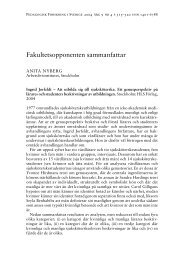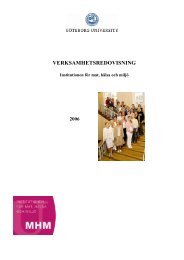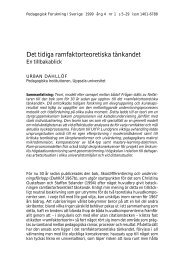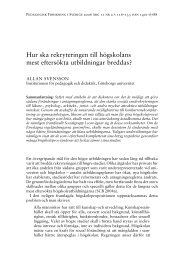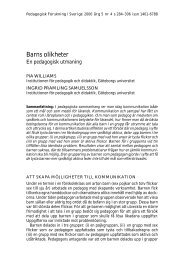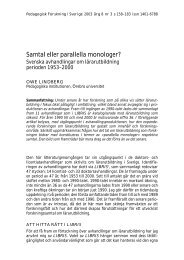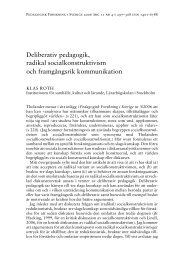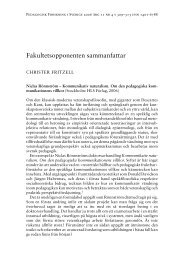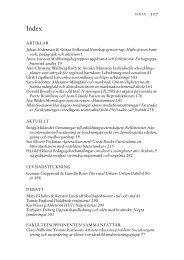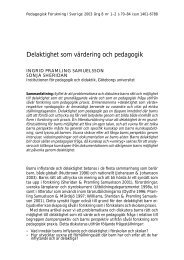University of Oslo Workshops June 29-30 Conference July 1-3 ...
University of Oslo Workshops June 29-30 Conference July 1-3 ...
University of Oslo Workshops June 29-30 Conference July 1-3 ...
Create successful ePaper yourself
Turn your PDF publications into a flip-book with our unique Google optimized e-Paper software.
Exploring Local Item Dependency for Items Clustered around Common<br />
Reading Passage in PIRLS Data<br />
Valerie Quittre, <strong>University</strong> <strong>of</strong> Liege, Belgium<br />
Christian Monseur, <strong>University</strong> <strong>of</strong> Liege, Belgium<br />
Since the IEA 1991 Reading Literacy Study (Elley, 1994; Wolf, 1995), cognitive data <strong>of</strong><br />
international assessments are usually scaled according to IRT models. One <strong>of</strong> the<br />
cornerstones <strong>of</strong> IRT models is the assumption <strong>of</strong> Local Item Independence (LII). In PIRLS<br />
assessment, as well as in other international assessments in reading literacy such as PISA<br />
(Organisation for Economic Cooperation and Development - OECD), testing material is<br />
hierarchically structured, i.e. several items are related to a common passage. Monseur & al<br />
(submitted) noted that “this test format may be viewed as the most appropriated to assess a<br />
complex process such as reading comprehension. In real life situation, students have to use<br />
different cognitive processes to understand various components <strong>of</strong> a same text”. This<br />
embedded structure might therefore violate the assumption <strong>of</strong> LII. As stated by Embretson<br />
and Reise (2000, p. 188), “Practically, local independence is violated when item responses<br />
are linked”. As noted by Balazs and De Boeck (2006, p. 2) “ignoring Local Item Dependence can<br />
have serious consequences for the goodness <strong>of</strong> fit <strong>of</strong> a model, for the parameter estimates and for<br />
confidence intervals.” This study was aimed at detecting passage-related local item dependencies in<br />
PIRLS 2006 cognitive data and estimating its relationship with the country performance.<br />
Keywords: local item dependency; IRT; PIRLS<br />
<br />
Differential Item Functioning in the Aspect <strong>of</strong> Gender Differences in Reading<br />
Literacy<br />
Antra Ozola, <strong>University</strong> <strong>of</strong> Latvia, Latvia<br />
Andrejs Geske, <strong>University</strong> <strong>of</strong> Latvia, Latvia<br />
The purpose <strong>of</strong> the study is to analyze the IEA PIRLS 2006 set <strong>of</strong> items in order to check if<br />
a differential item functioning (DIF) can be noticed. The groups <strong>of</strong> comparison are based<br />
on gender since PIRLS 2006 study has showed that Latvia has the 6th largest gender gap in<br />
reading literacy scores. So the DIF analysis is expected to show if an instrument could be<br />
one <strong>of</strong> the reasons <strong>of</strong> the gender gap in achievement. Items easiest and hardest for each sex<br />
are found as well as items with the biggest and smallest DIF values to check if an item<br />
format gives any advantages or disadvantages to any <strong>of</strong> the gender groups <strong>of</strong> Latvian<br />
students. The results show that the set <strong>of</strong> PIRLS 2006 items does not have any gender bias<br />
on Latvian students since there are items with no DIF at all and there is almost equal<br />
number <strong>of</strong> items with DIF in favor <strong>of</strong> each <strong>of</strong> the sexes. The length <strong>of</strong> the item stem does<br />
not have any correlation with the item difficulty or differential item functioning between<br />
sexes. There is no difference in DIF when the items <strong>of</strong> literary and informative texts are<br />
compared and the same is true for multiple choice and constructed response items. The<br />
main conclusion is that the achievement gap between boys and girls in Latvia is caused by<br />
the differences in their skills/abilities and not by a differential item functioning.<br />
Keywords: secondary analysis; differential item functioning; PIRLS; reading literacy;<br />
gender differences<br />
46



